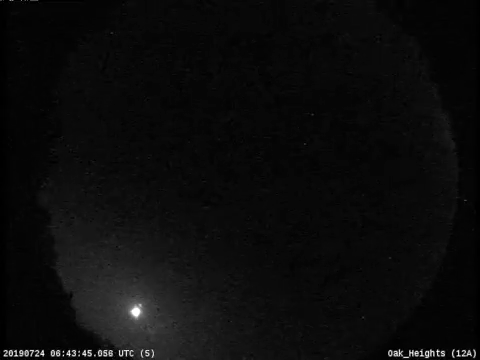Mysterious, Ultrabright Fireball Streaks Across the Sky Over Canada
In the wee hours of Wednesday morning, a fiery space rock as bright as the full moon hurled through the sky above Ontario, sending out bright flares at the end of its celestial journey near Bancroft.
The Western University All-Sky Camera Network picked up the fireball at 2:44 a.m. ET (July 24) across southern Ontario and Quebec. The fireball — which is a meteor that is unusually bright — was about 400,000 times fainter than the sun, or about the brightness of the full moon, according to Sky & Telescope. From the astronomers' analysis, they think the meteoroid that created the fireball was about the size of a small beachball, or nearly 12 inches (30 centimeters) across.
When these meteors reach Earth's atmosphere, both friction from the atmosphere and the bow shock that forms in front of the space rock heat it up. The result? The fireball can break apart into fragments. [See Photos of a Meteor Explosion Over Russia]

"This fireball likely dropped a small number of meteorites in the Bancroft area, specifically near the small town of Cardiff," Peter Brown, an expert in meteors at Western University, said in a statement. "We suspect meteorites made it to the ground because the fireball ended very low in the atmosphere just to the west of Bancroft and slowed down significantly. This is a good indicator that material survived."
The university's camera network captured the fiery rock's trek through the atmosphere on video, which will help researchers figure out where in the solar system it originated, according to the statement.
Steven Ehlert of NASA's Meteoroid Environment Office analyzed the video, saying these fragments likely hit the ground near Bancroft, Ontario. (The camera network is run jointly by Western University and this NASA office at the Marshall Space Flight Center in Huntsville, Alabama.)
From their preliminary analysis, the researchers think the fireball first lit up the skies at an altitude of 58 miles (93 kilometers) just south of Oshawa over Lake Ontario, before dashing over Clarington and passing just west of Peterborough. Finally, the fireball appears to have extinguished itself just west of Bancroft, according to the university's statement.
Sign up for the Live Science daily newsletter now
Get the world’s most fascinating discoveries delivered straight to your inbox.
These meteorite fragments were in the size-range of tens to hundreds of grams when they hit the ground, the researchers said.
Brown and his colleagues are asking that anyone who may have heard anything unusual this morning or who has found a possible meteorite to contact them at Western University or the Royal Ontario Museum.
If you find a suspicious rock, here are a few tips to help you figure out if it's a meteorite:
- Meteorites tend to be dark, with a scalloped surface.
- They are typically more dense than an average rock.
- Due to their metal content, meteorites are often attracted to magnets.
If it seems to be a meteorite, place it in a clean plastic bag or aluminum foil.
- Crash! 10 Biggest Impact Craters on Earth
- In Photos: The Impact Craters of North America
- Fallen Stars: A Gallery of Famous Meteorites
Originally published on Live Science.

Jeanna served as editor-in-chief of Live Science. Previously, she was an assistant editor at Scholastic's Science World magazine. Jeanna has an English degree from Salisbury University, a master's degree in biogeochemistry and environmental sciences from the University of Maryland, and a graduate science journalism degree from New York University. She has worked as a biologist in Florida, where she monitored wetlands and did field surveys for endangered species. She also received an ocean sciences journalism fellowship from Woods Hole Oceanographic Institution.
Most Popular


